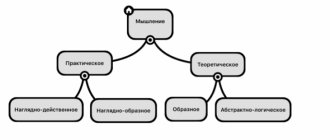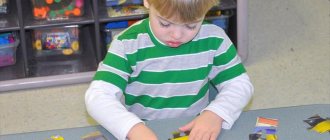Dyscalculia is the inability to operate with mathematical categories, the inability to understand the essence of arithmetic operations, the concepts of “number”, “sum”, “triangle” and the like. As a rule, this disorder appears in children of preschool and primary school age, but it can also occur in adults. Dyscalculia is difficult to diagnose for a non-specialist, so children with this pathology often end up in specialized classes for schoolchildren with mental development disorders.
Approximately 10% of schoolchildren suffer from some form of dyscalculia. Not all parents know that with timely diagnosis even in preschool age, effective measures can be taken to prevent this pathology and make it easier for the child to master the school curriculum.
If a child suffers from manifestations of dyscalculia, he experiences a negative attitude towards the “exact sciences”. Chronic underachievement can also affect mastery of humanities subjects, as well as cause a student’s low social status. He does not have good relationships with his peers, and teachers and parents often put unjustifiably strong pressure on him because of his perceived laziness and lack of diligence. In the future, such children experience difficulties with choosing a profession and self-realization.
Reasons for the occurrence of the violation
The development of pathology is caused by:
- Fear of arithmetic - the violation is based on the negative experience of learning to count through coercion and punishment. This unusual phobia is due to the fact that when solving arithmetic examples, especially problems, the child had difficulties or was often scolded and punished. Over time, he developed fear and self-doubt for fear of being punished.
- Social problems. They most often occur in children who are brought up in conditions of pedagogical neglect, in a dysfunctional family.
- Damage to the parietal lobe of the cerebral cortex due to the pathology of pregnancy and childbirth, brain injuries and neuroinfections, tumors and genetically determined defects.
In adults, this problem often appears due to disruption of the brain. Its occurrence can be caused by hemorrhages, organic lesions in the temporal region, tumors, blood clots, cysts and traumatic brain injuries. Various psychological traumas can also provoke the occurrence of dyscalculia. If you have problems using mathematical knowledge, you should contact a neuropsychiatrist.
Dyscalculia in children often occurs due to disorders of mental activity. These include:
- disturbance in the processing of visual information;
- decreased concentration;
- violation of logical thinking;
- problems with assimilation and memorization of information.
Dyscalculia can be combined with reading and writing disorders such as dysgraphia and dyslexia, as well as ADHD (attention deficit hyperactivity disorder).
Diagnostic measures
If symptoms of a suspected disorder are identified, you should contact a school psychologist or speech therapist. If the clinical manifestations are severe, then a psychiatrist deals with the issues of diagnosis and treatment. In rare cases, the disease is diagnosed in adolescents.
The disease is diagnosed using an algorithm that confirms impairments in calculation and other cognitive skills. The examination consists of:
- Collection of existing complaints and medical history. It is important to establish the nature of the course of pregnancy and childbirth, the conditions of upbringing, as well as the presence of signs of similar symptoms in the child’s parents.
- An examination during which the doctor examines neurological functions and mental health. If changes are detected, differential diagnosis with organic brain lesions should be carried out.
- Assessments of skills and abilities in the field of mathematics. Schoolchildren are asked to count to ten and back, compare objects by size and quantity, correctly name geometric shapes, and solve simple examples. Additionally, the ability to navigate in space, including using a map, and perform complex actions following instructions in several stages is assessed. When diagnosing dyscalculia in children of preschool and early school age, they are asked to perform simple tasks: arrange numbers in order of increase or decrease, compare them. It is important to remember that tasks should be selected in accordance with age standards.
- Tests for dyscalculia, consisting of tasks for recoding information. The teenager is required to translate verbal structures into mathematical symbols. To do this, he is offered various formulas, fractions, etc.
- Electroencephalography (EEG) or magnetic resonance imaging (MRI) is performed if organic brain damage is suspected.
Differential diagnosis of dyscalculia must be carried out with a number of pathological conditions, such as pedagogical neglect, mental retardation and mental retardation. In children with the disease, only the ability to perform arithmetic calculations decreases, while all other areas (intelligence, memory, etc.) remain within the age norm.
Symptoms of the problem
Children suffering from dyscalculia are not able to understand what a number is and on what principle the number series is built; they cannot distinguish and remember numbers. They cannot perform operations with numerical values and do not know how to decompose them into terms. It is difficult for them to compare the number of objects, perform simple arithmetic operations and carry out calculations according to the internal plan, that is, to count “in their minds”.
Symptoms of dyscalculia:
- difficulty recognizing and writing numbers;
- inability to tell time and navigate hours, minutes, seconds;
- impaired coordination of fine movements;
- inability to determine the distance traveled or measure the length of a segment;
- difficulty in perceiving the concepts “less” and “more”;
- the impossibility of solving problems without illustrative support;
- difficulties in solving logical problems and performing actions with abstract categories;
- inability to visually determine the number of objects, putting them into groups without counting them one by one.
As soon as relatives discover the above symptoms in a child, you should immediately seek advice from a speech therapist or psychotherapist. The specialist will conduct a differential diagnosis, determine the form of the disorder, identify the causes of its occurrence and develop an effective correction method.
Due to a violation in the processing of visual information, the child can solve examples only if their objective component is present. The child cannot independently imagine what is written in the task conditions. In addition, schoolchildren in primary grades are unable to rationally calculate their free time, which leads to poor academic performance and behavior problems in the future. This aspect is described quite fully in the video below:
Types, manifestations of dyscalculia and methods of its correction
Some children may begin to have problems understanding numbers in preschool. In other cases, they appear as mathematics becomes more complex, the child moves from class to class...
A child suffering from an illness may have a violation of either one or a number of processes involved in the formation of arithmetic skills. Analyzing the symptoms of the disorder, the following types of dyscalculia are distinguished:
This table can be supplemented with the so-called pseudodyscalculia - a violation of the acquisition of the basics of mathematics due to a reluctance to learn, or due to an illiterately structured learning process.
Children with dyscalculia experience difficulties
- with the understanding that, for example, the number 5 is the same as the word "five", and that they both mean five things;
- with the study of the multiplication table;
- with monetary transactions: count money, determine value, change;
- with time determination and orientation in hours, minutes, seconds;
- with an estimate of speed or distance;
- with an understanding of the logic of mathematical problems;
- with coordination of movements;
- with memorizing dates, phone numbers, formulas;
- with the study of drawing, physics, chemistry...
Such children, as a rule, get tired quickly, have low performance, a reduced rate of mental processes...
Forms of dyscalculia
It can be congenital or acquired, primary or secondary. Experts identify the following forms:
- Practognostic – the inability to keep an abstract count, to classify objects by shape, size, quantity.
- Verbal – the inability to name numbers, geometric figures and the actions that are performed with them.
- Graphic – problems with converting numbers into digit form, depicting mathematical symbols, and geometric figures.
- Lexical – characterized by errors in reading arithmetic signs and numbers, in understanding the terms of the problem, the essence of mathematical operations, and violations of spatial visualization.
- Operational – the child has difficulty performing simple arithmetic operations and solving basic examples and problems.
- Arithmeria is the inability to learn computational operations.
- Pseudodyscalculia is a violation of the mastery of mathematics due to reduced motivation for learning and poorly organized learning process.
In some cases, children suffering from dyscalculia may experience symptoms of several forms of this disease. After determining the type, the specialist develops therapy aimed at correcting the disorder and further preventing the development of other forms in the child.
There is such a thing as acalculia - this is a neuropsychological symptom that manifests itself in a violation of counting and counting operations due to damage to various parts of the cerebral cortex. It should not be confused with dyscalculia.
What is dyscalculia?
Greetings, dear readers!
The other day I unwittingly witnessed a conversation between two mothers:
“...My son doesn’t understand anything in mathematics! He is afraid of her and has difficulty doing what is easy for others! We urgently need a tutor!”
Do you need a tutor?
If the problem occurs every now and then, it probably does! But, if a child has constant difficulties with counting and consistently low grades in mathematics, the reason may be dyscalculia!
What is this?
Dyscalculia is thought to be equally common among boys and girls. And while the condition is not as well known or understood as dyslexia, some experts say it affects between 5% and 10% of people in the world.
According to experts, it is possible to give a child such a diagnosis no earlier than 5-6 years of age, since it is from this age that the first arithmetic abilities and skills in working with abstract symbols and actions begin to develop.
Dyscalculia is a disorder that accompanies a person throughout his life and causes him a lot of inconvenience. Cooking, going to the store, orienting oneself in time and space can be a serious challenge for people with no “number sense”... But don’t despair. Today, there are techniques that can compensate for impaired brain functions and help solve problems caused by dyscalculia.
Test tasks for diagnostics
You can suspect dyscalculia in a child even before school starts. It is enough to ask a 5-7 year old child to count something, after which you can see that performing basic mathematical operations causes him significant difficulties.
Test tasks for children of primary school age:
- count from 10 to 20 (counting up to 10 can be perfect);
- arrange numbers in ascending and descending order;
- compare two numbers;
- determine the name of geometric shapes, classify them by color, size;
- perform arithmetic operations (addition and subtraction);
- analyze the human body diagram;
- determine the direction left and right.
After the examination, the specialist can accurately determine the form of dyscalculia and begin work on its correction.
Types of disorder
Various mechanisms of development of the disorder cause violations of individual stages of working with abstract symbols. Depending on this, there are several types of dyscalculia:
- graphic – manifested by difficulties in the written display of mathematical symbols and numbers, the impossibility of accurately reproducing geometric figures is noted;
- practical-gnostic – associated with impaired understanding of abstract mathematical concepts, children cannot translate them into concrete examples, which makes it difficult to solve problems or explain mathematical operations performed;
- lexical – manifested by impaired reading of mathematical signs and numbers, the ability to perceive information and learn by listening to a teacher or parents is preserved, but there is no understanding of educational material when reading independently;
- verbal – impairments in the perception of mathematical concepts by ear and difficulties in naming them are revealed, while written tasks are completed easily;
- operating room – manifested by impairments in oral and written solving of problems with mathematical operations;
- ideological - associated with the inability to conduct mental reflections and calculations without relying on mathematical concepts; such people need to keep written notes, sketch out problems or use sticks.
Regardless of the causes of development, individual types of dyscalculia can be combined. This leads to complexity in the perception of information and makes it difficult to master the exact sciences.
How is dyscalculia corrected?
Correction (treatment) is carried out in a clinic or specialized medical center. The following specialists are involved in this: psychoneurologist, neuropathologist, child psychologist, speech therapist. The main treatment is carried out in a playful way; specialized computer programs and interactive sessions between the child and a specialist can be used.
On average, 30–90 sessions are required to eliminate the problem; in severe cases, their number reaches 250.
Methods and exercises for correction:
- solving problems close to life situations (in a store, in the family, while walking);
- imitation of objects with sticks, matches, buttons and other improvised materials;
- creation by the teacher of diagrams and memos containing an algorithm for completing tasks;
- transition from verbal pronunciation of one’s actions to the internal plan;
- measuring objects with a ruler, determining values by eye, weighing bulk objects, measuring the volume of liquids;
- training in automatic perception of groups of objects up to five pieces, all components of the group must have a different color and size;
- accompanying the solution of problems with a drawing performed by the child.
Various games for young patients suffering from this pathology are aimed at teaching counting and performing basic mathematical operations. The baby is taught to sort objects according to various characteristics. After this, the specialist helps the child master simple mathematical problems and operations. During the training, it is necessary to ensure that the little patient understands the sequence of banal operations and actions he performs. Next, the child is explained how to correctly separate numbers and objects into parts and assemble them into a single whole.
To get rid of this pathology, it is necessary to work with the child from an early age, sort shapes, seeds, cereals, transfer them into various containers, accompany all these tasks with speech, and also introduce mathematical terms (one-many, numbers, shapes, etc.). d.). You need to teach your child to correctly name numbers, geometric shapes, their characteristics (size, color) and the actions performed on them.
Next, the child learns to correctly use the learned terms and words in everyday life, in conversations with relatives, peers, and friends. Particular attention must be paid to translating spoken symbols into written form. The child must definitely learn to write numerical values and arithmetic signs correctly.
Along with the correction of dyscalculia, it is also necessary to develop abstract and logical thinking, visual memory, spatial orientation and musical abilities in the baby. He must learn to independently control his actions and the ability to correctly distribute personal time. Here is an example of several exercises:
To treat this disorder in a child or adult, doctors can prescribe certain medications, such as Glycine, Cortexin and B vitamins. It is doctors, but not speech therapists or speech pathologists (unfortunately, they often prescribe medications, although they do not have the right to do so ).
Dyscalculia: how to help a child who is confused with numbers
We all know that some children have learning difficulties. And they may not arise because children lack motivation or because parents do not do enough with them at home. Sometimes the reason is congenital developmental features.
Dyslexia (that is, difficulty with reading and writing) has already become quite well known, but in addition to it, there is also lesser known dyscalculia (that is, confusion in numbers and performing simple arithmetic tasks). Let's figure out what it is and how you can help a child with such a problem.
What is the reason?
Researchers estimate that dyscalculia can be diagnosed in approximately three to seven percent of the population, and its prevalence does not depend on the child's gender. As is the case with dyslexia, this feature is transmitted at the gene level. This means that a person is more likely to have dyscalculia if there is a history of dyscalculia in the family. Dyslexia and dyscalculia often come in the same package.
So far, not much research has been conducted on dyscalculia, and most often on adult respondents with various difficulties in remembering numbers, determining the number of objects, as well as in solving simple arithmetic problems. Therefore, it is not yet possible to say with certainty which part of the brain is responsible for this disorder in children.
When and how to understand that a child has dyscalculia?
At the moment, it is believed that the first arithmetic abilities - the ability to distinguish where a larger number of objects are collected and where fewer - appear in children at the age of 4-6 months. We most likely inherited this skill from animals: after all, in nature it is important to be able to quickly figure out which bush has the most ripe berries, so as not to go hungry.
By the age of six - which is when school starts in most countries - children can usually count and do some math (addition and subtraction). But sometimes even with these simple tasks difficulties can arise.
By what parameters can you understand that a child aged about six years has dyscalculia?
A child cannot recognize by eye the number of objects in a small group (for example, there are three identical cups on the table, but he will not be able to name their number).
A child at this age has difficulty writing numbers; he confuses 3 and 8, 9 and 6, and the child often writes numbers upside down.
The child often confuses similar-sounding numbers (for example, “six” and “seven”, “twelve” and “thirteen”).
The child misses some numbers when asked to count from one to twenty.
The child has difficulty solving simple math problems. For example: “How many cups will remain on the table if one of the three cups is removed?”
It is difficult for a child to indicate the location of a certain number on a number line. That is, he can hardly answer the following question: “What number is between the numbers eight and ten?”
In elementary school, the following signs are added:
The child confuses addition and subtraction signs.
A child can solve mathematical problems only by helping himself to count on his fingers.
The child cannot cope with tasks to compare the number of objects.
At the same time, dyscalculia may also have other features associated with the channels of information perception: some children have a particularly difficult time perceiving mathematical tasks by ear, but these students can successfully solve examples in written form. It is difficult for someone to understand what the point of a task is if the child is expected to read it and figure it out on his own.
If left unattended, dyscalculia can lead to serious learning problems in the future: the child will not have a positive experience in mathematics lessons, and his motivation to learn will decline.
According to some studies, as adults, people with dyscalculia earn less and manage their money worse; they are more likely to encounter everyday difficulties in making payments. And a number of experts even more so believe that dyscalculia of the population even reduces the country’s GDP.
What is important to understand:
Dyscalculia does not depend on a person’s level of intelligence, stubbornness, or desire to understand something.
If you notice that your child is confused with numbers, then you need to direct efforts to improve the situation.
How can we help?
Don't blame yourself or shame your child
Be sure to remind him that he has many other talents, that he is good at many other things. And motivate him - after all, if you arm yourself with patience, then difficulties with mathematics can be partially overcome.
Show your child that you understand that this is an area of knowledge that is still difficult for him. Tell him about what subjects you yourself found difficult to cope with at school.
Use knowledge in life
Take your child with you to the grocery store and give him tasks: for example, put four apples, five cucumbers, eight tomatoes in a basket. Ask him which yogurt is more profitable to buy - for 35 or 47 rubles?
Draw your child's attention to the clock more often
For example, you can ask him to be responsible for ensuring that the whole family gathers for dinner at seven o'clock in the evening or for tea at five o'clock.
Play more games with your child where you need to recognize the number of objects
A great example is dominoes, a classic game with a simple arithmetic principle that teaches you to judge by eye how many dots are on your dominoes. But you don't have to play at home.
While walking you can count red cars. Or count the steps as you go up to your floor. Or on the playground, you can count together how many times your child has jumped rope - in general, try to unobtrusively integrate counting into the game.
More practice
For example, buy a kitchen scale and involve your child in the cooking process - let him weigh different ingredients according to your instructions.
Don’t forbid your child to use his fingers to count if he still has a hard time counting in his head.
Fingers are truly our first and most important calculator (and how symbolic it is that we have ten fingers on our hands - isn’t this why the decimal number system arose?).
Use special programs
Special educational computer programs, for example The number Race, Number Bonds, can help correct dyscalculia.
Positive reinforcement is important
Praise your child even for small math successes.
Evaluate the possibilities sensibly
Try not to give your child too difficult tasks so as not to destroy the child's motivation. Don't scold for mistakes.
Don't expect complete relief from dyscalculia
Some problems with mental calculations may remain in a child even after all the lessons. But it is important that learning difficulties do not break your parent-child relationship and do not become a central battle. All children are different and each has their own strengths and weaknesses, do not forget about this.
Work together
Be sure to try talking to your school teacher about your child's learning difficulties. Some teachers are not yet very knowledgeable about concepts such as dyslexia and dyscalculia. But if this teacher hears one of these words from you, then perhaps it will make him go deeper into the topic. The education system will definitely change, let's help change it together with teachers.
Read more on the topic
A 10-year-old girl wrote a poem about dyslexia that can be read both ways.
Why do parents get so angry about doing homework with their children and what to do about it
7 questions for a children's speech therapist
CHIPS news
Listen to our podcast
Prevention methods
Precautionary measures to prevent dyscalculia can be carried out in early preschool childhood. First of all, the most complete correction of existing neurological pathologies should be carried out. At an early age, you can start learning basic mathematics in a playful way.
Parents should clearly demonstrate to their child how to count objects, shapes and perform basic mathematical tasks, for example, while swimming, you can ask your child to count blue balls or catch three red balls with a net. When teaching a child to count, it is necessary to carefully pronounce the names of numbers, and then arithmetic operations. You can show the number of objects to the child on your fingers or using small toys and objects. Gradually, you need to teach your child to correlate the number of objects with a specific number.
To prevent a child from developing operational dyscalculia, he must be taught the rules of counting and the order of mathematical operations. To prevent verbal and lexical problems, it is necessary to ask the child to say the name of the numbers when counting, and when looking at various figures and other objects - their color and shape. Parents should monitor the correct use of certain symbols and, if their child makes mistakes, calmly correct them, without using harsh punishments.
To prevent the occurrence of dyscalculia in graphic form, it is necessary to pay special attention to the development of the child’s visual memory, fine motor skills, coordination of movements through finger and outdoor games, collecting cut pictures, cubes, puzzles, playing with small parts of the construction set, stringing beads on a cord, identifying them shape and color. The productive activities of children are very effective in this regard - modeling, drawing, appliqué, making crafts, origami.
Moms and dads must pay attention to the development of thinking and memory in the child, and then, in the future, the occurrence of dyscalculia can be avoided.
Prevention options and prognosis
Prevention of the disease is based on the classification of dyscalculia, since each type of disorder requires its own approach.
Preventing the development of graphic type disorders requires exercises that improve the perception of visual images, fine motor skills and train various types of memory. It is important to remember that with dyscalculia there are some features of visual gnosis. Their prevention is based on the use of various visual materials.
Practognostic disorder can be prevented by timely teaching a preschooler basic arithmetic skills. In this case, you should talk through the progress of the calculations, voice the result and monitor the formation of the correct perception of mathematical operations. In addition, parents should work on developing spatial awareness and spatial coordination.
To prevent dyslexia, perform exercises aimed at developing visual perception. Children are taught about shape, color, and taught to perceive and recognize various mathematical symbols. It is important to teach your child to match them with the correct name and purpose during arithmetic calculations.
Verbal dyscalculia develops against the background of a lack of lessons with a preschooler on understanding mathematical operations and their essence. You should perform exercises to correctly name actions, understand the differences between colors, shapes and sizes of objects. In this case, the child must pronounce these differences out loud.
Prevention of operational disorder requires timely training in arithmetic operations. The child should be involved in this activity, and not forced to solve examples without any explanation.
In addition to specific prevention, it is necessary to follow general recommendations: organize a proper sleep and rest schedule, a balanced diet, regular physical activity, etc. If you have the first problems with mastering mathematics, you should consult with a psychologist or teacher. They will help determine the nature of the disorder and, if necessary, refer parents to consultation with specialists.
SYMPTOMS OF DYSCALCULIA
Signs of dyscalculia in children may include the following:
- Doesn't name numbers correctly.
- The child remembers the numerical order, but does not understand the meaning.
- Has difficulty finding the place of a number among other numbers.
- Poor knowledge of arithmetic terminology.
- Doesn't understand how a number is decomposed into terms.
- Has difficulty placing numbers in greater/lesser order.
- Numbers are written with errors.
- The child is able to solve basic arithmetic problems, but using only manual calculation.
- Children with dyscalculia think narrowly in terms of problem solving. A positive answer may be provided that there is a subject condition.
- It is difficult to reproduce an arithmetic sequence in the process of solving problems.
- The child does not solve problems with complex numbers, or great efforts are made.










